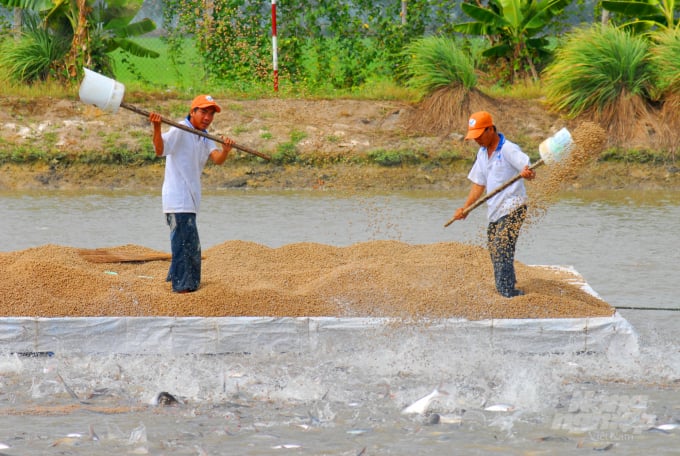May 19, 2025 | 04:45 GMT +7
May 19, 2025 | 04:45 GMT +7
Hotline: 0913.378.918
May 19, 2025 | 04:45 GMT +7
Hotline: 0913.378.918

High-tech pangasius farming model in An Giang. Photo: Le Hoang Vu.
In recent years, Vietnam's pangasius industry has faced many difficulties in production and export due to many adverse factors such as climate change, fish diseases, high production costs of raw fish, technical barriers, and strict regulations from the export market.
Therefore, high technology application in production contributes to improving the added value of pangasius and gradually brings the strength of this product to more sustainable development.
The high-tech pangasius farming project of Nam Viet Joint Stock Company is deployed in Binh Phu commune, Chau Phu district, An Giang province, with an area of 600 hectares, with a total investment of VND 4,000 billion, divided into two zones. The production zone of the high-quality 3-level pangasius fingerling has an area of 150 hectares, with an investment of VND 1,000 billion; the High-tech agricultural area for aquaculture and commercial catfish farming has an area of 450 hectares, with an investment of VND 3,000 billion.
Mr. Doan Toi, General Director of Nam Viet Joint Stock Company, said: High-quality 3-level pangasius breed production zone produces about 360 million pangasius fingerlings each year.

Former Minister of Agriculture and Rural Development Nguyen Xuan Cuong and Deputy Minister of Agriculture and Rural Development Phung Duc Tien (3rd and 4th from the right) visit the high-tech pangasius farming model of Nam Viet Joint Stock Company. Photo: Le Hoang Vu.
The whole farming zone is invested with modern equipment, nano-aeration technology, and Bakture catalyst to treat water in the pond; there is no need to discharge pond water into the environment and dredge and remove sludge bottom the mechanical method as before.
“We raise pangasius in a high-tech closed double cycle. Fish manure is recovered to make organic fertilizer. The water surface on the pond takes advantage of placing solar power panels to supply the whole farming area.
Vinh Hoan Joint Stock Company in Dong Thap has also established and located the headquarters of Vinh Hoan Pangasius Breed Production Company Limited in Vinh Buong Hamlet, Tan Chau Town (An Giang province), also focusing on implementing production projects of 3-level pangasius fingerlings with high technology application here. With nearly 50 hectares, the project aims to provide 1.6 billion fingerlings and 30 million fingerlings of pangasius per year.

Vinh Hoan has completed producing the 3-level pangasius breed with high technology. Photo: Le Hoang Vu.
The difficulties during the "storm" of Covid-19 forced large enterprises like Vinh Hoan to change their thinking in pangasius production.
Ms. Truong Thi Le Khanh, Chairman of the Board of Directors of Vinh Hoan Joint Stock Company, said: For fish to develop sustainably, it is necessary to change awareness from breed, water environment, farming method, and technological process. Export processing must follow a closed and circulating chain, applying high technology.
Currently, Vinh Hoan has completed producing the 3-level pangasius breed with high technology. Also, develop a farming process according to high-tech standards and vaccinate fish right at the hatchery before raising, without using antibiotics during the rearing process.
Mr. Tran Anh Thu, Vice Chairman of An Giang Provincial People's Committee, said: Pangasius is one of the two main export agricultural products of An Giang province. Each year the province has a total farming area of nearly 1,000 hectares.

An Giang mainly focuses on large-scale farming areas and high-tech agricultural zones associated with consumption. Photo: Le Hoang Vu.
For the pangasius industry to develop sustainably in the coming time, An Giang has always focused on promoting the implementation of the high-quality 3-level pangasius breed chain. The province has called for four enterprises to invest in high-tech intensive nursery areas, including Vietnam - Australia Group; Nam Viet Joint Stock Company; Vinh Hoan Joint Stock Company; Loc Kim Chi Development Company Limited.
Currently, An Giang mainly focuses on large-scale farming areas and high-tech agricultural zones associated with consumption. Also, develop a chain-based industrial farming process, from fingerlings to rearing and processing, to ensure the quality of rearing and reduce diseases.
Mr. Nguyen Sy Lam, Director of the Department of Agriculture and Rural Development of An Giang province, said that An Giang's agricultural sector would continue to support seafood businesses in implementing investment projects in breeding production areas and high-tech aquaculture.
"Only applying technology to production and management can help reduce farming costs, increase competitiveness, and gradually bring pangasius to a more sustainable development," Mr. Nguyen Sy Lam emphasized.
Translated by: Ha Phuc

(VAN) 14 out of 35 domesticated elephants in Dak Lak province have had their living conditions improved, with 11 of them currently participating in the non-riding elephant tourism model.

(VAN) Muong Nhe Nature Reserve hopes that being upgraded to a national park will lay the foundation for forest protection efforts to be carried out in a systematic, modern, and sustainable manner.
/2025/05/16/3923-2-171845_52.jpg)
(VAN) Lower costs, higher yields, and improved soil quality are outstanding benefits that soybeans bring when integrated into the crop rotation system.

(VAN) The 'For a Green National Environment' programme aims to promote a green lifestyle, support businesses in implementing ESG practices, and turn Net Zero commitments into concrete actions.

(VAN) Cold-barn systems efficiently manage environmental and temperature conditions, which aids in the prevention of respiratory diseases in pigs and protects them from the vectors that transmit African swine fevers.

(VAN) To tackle challenges, the project 'Addressing key technical bottlenecks in the grouper supply chain in Vietnam' has been underway since 2024.

(VAN) The project 'Disease-Resilient and Sustainable Cassava Production Systems in the Mekong Region', funded by the Australian Center for International Agricultural Research (ACIAR), is being implemented from 2024 to 2028.